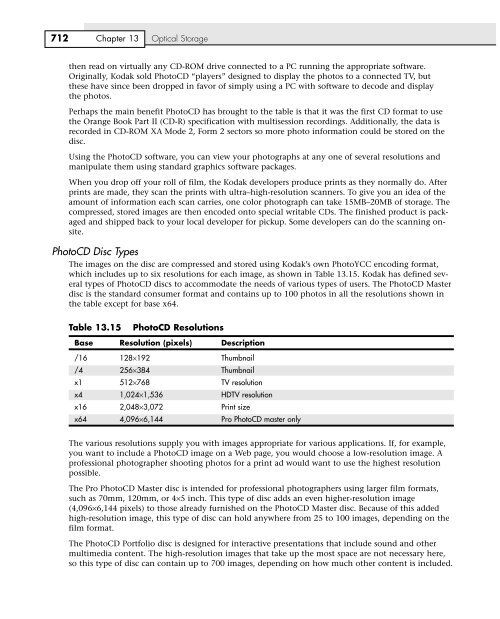Create successful ePaper yourself
Turn your PDF publications into a flip-book with our unique Google optimized e-Paper software.
712 Chapter <strong>13</strong> Optical Storage<br />
then read on virtually any CD-ROM drive connected to a PC running the appropriate software.<br />
Originally, Kodak sold PhotoCD “players” designed to display the photos to a connected TV, but<br />
these have since been dropped in favor of simply using a PC with software to decode and display<br />
the photos.<br />
Perhaps the main benefit PhotoCD has brought to the table is that it was the first CD format to use<br />
the Orange Book Part II (CD-R) specification with multisession recordings. Additionally, the data is<br />
recorded in CD-ROM XA Mode 2, Form 2 sectors so more photo information could be stored on the<br />
disc.<br />
Using the PhotoCD software, you can view your photographs at any one of several resolutions and<br />
manipulate them using standard graphics software packages.<br />
When you drop off your roll of film, the Kodak developers produce prints as they normally do. After<br />
prints are made, they scan the prints with ultra–high-resolution scanners. To give you an idea of the<br />
amount of information each scan carries, one color photograph can take 15MB–20MB of storage. The<br />
compressed, stored images are then encoded onto special writable CDs. The finished product is packaged<br />
and shipped back to your local developer for pickup. Some developers can do the scanning onsite.<br />
PhotoCD Disc Types<br />
The images on the disc are compressed and stored using Kodak’s own PhotoYCC encoding format,<br />
which includes up to six resolutions for each image, as shown in Table <strong>13</strong>.15. Kodak has defined several<br />
types of PhotoCD discs to accommodate the needs of various types of users. The PhotoCD Master<br />
disc is the standard consumer format and contains up to 100 photos in all the resolutions shown in<br />
the table except for base x64.<br />
Table <strong>13</strong>.15 PhotoCD Resolutions<br />
Base Resolution (pixels) Description<br />
/16 128×192 Thumbnail<br />
/4 256×384 Thumbnail<br />
x1 512×768 TV resolution<br />
x4 1,024×1,536 HDTV resolution<br />
x16 2,048×3,072 Print size<br />
x64 4,096×6,144 Pro PhotoCD master only<br />
The various resolutions supply you with images appropriate for various applications. If, for example,<br />
you want to include a PhotoCD image on a Web page, you would choose a low-resolution image. A<br />
professional photographer shooting photos for a print ad would want to use the highest resolution<br />
possible.<br />
The Pro PhotoCD Master disc is intended for professional photographers using larger film formats,<br />
such as 70mm, 120mm, or 4×5 inch. This type of disc adds an even higher-resolution image<br />
(4,096×6,144 pixels) to those already furnished on the PhotoCD Master disc. Because of this added<br />
high-resolution image, this type of disc can hold anywhere from 25 to 100 images, depending on the<br />
film format.<br />
The PhotoCD Portfolio disc is designed for interactive presentations that include sound and other<br />
multimedia content. The high-resolution images that take up the most space are not necessary here,<br />
so this type of disc can contain up to 700 images, depending on how much other content is included.
















